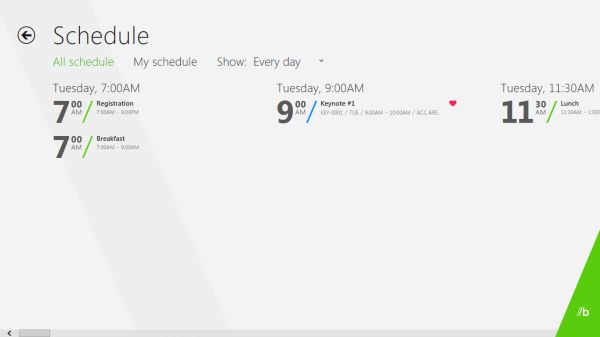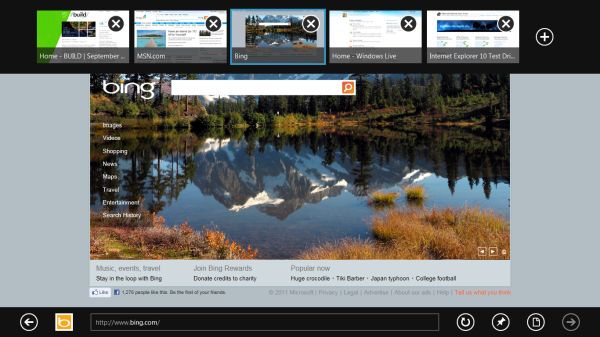Microsoft BUILD: Windows 8, A Pre-Beta Preview
by Brian Klug & Ryan Smith on September 13, 2011 12:05 PM EST- Posted in
- BUILD
- Windows
- Microsoft
- Windows 8
- Trade Shows
The Desktop User Experience & Business Use
While we’re primarily focusing on Windows 8 as a tablet OS since the hardware we used was a tablet, we also wanted to evaluate it some as a desktop OS. As the sample tablet was compatible with Bluetooth peripherals, we were able to pull out a BT keyboard and mouse and use it like a traditional laptop/desktop environment. With that said I’d like to preface our impressions with the following: as it stands Windows 8 is clearly focused on tablets first and Microsoft’s presentation was equally tablet focused, and it’s almost certain the experience will change before Windows 8 ships.
Overall Windows 8 is extremely jarring right now from a desktop user perspective. Metro is the Windows shell, no ifs ands or butts. Metro applications can only be accessed through the Metro shell (i.e. the Start Screen), and the Metro shell is always what the tablet will boot up into. Explorer as we know it is the Metro shell – if you kill it, you kill Metro shell with it – so at this time it’s not possible to boot up into the traditional Windows desktop. Even if you could, the Start Menu is gone, replaced with Metro charms.
So what we’re really evaluating is the ability to use the Metro shell and Metro applications with a mouse. For all the good Microsoft has done implementing multi-touch, the mouse has clearly suffered as it currently stands. Click & drag does not operate the same as tap & drag, which creates some oddities when you want to scroll around. In fact scrolling is probably the biggest oversight right now, as the Metro style dictates applications are laid out left-to-right rather than top-to-bottom. The mouse wheel will (slowly) scroll through tiles on the Start Screen, but in other places such as the Microsoft BUILD application the mouse wheel is useless. In its place you have to drag a scroll bar around, which is about as fun as it was prior to mice coming with a wheel.
Internet Explorer is particularly weird. Because it takes the full screen approach there isn’t a menu bar to speak of, and the tabs and URL bar are hidden. Invoking them requires right-clicking, with right-clicking pulling double duty as a way to open a link in a new tab and invoking the various bars. This also means that right-clicking for other purposes (e.g. View Source, etc) are unavailable.
The good news is that most of the traditional keyboard shortcuts still work, including Alt-Tab, WinKey + D, WinKey + E, and Ctrl-Alt-Esc. You can even Alt-Tab between launched Metro applications. The Start Menu search bar is also faithfully replicated on the Start Screen, so when you start typing Windows 8 will start narrowing down results of things to open. So overall keyboard users maintain much of their advantage in quickly executing applications. At the same time we’ve encountered fields that we can’t tab to, so not everything is working as it should.
While we’ve only had a short period of time work play with Windows 8 with a mouse and keyboard, at this point in time there’s not a lot to say that’s positive. Metro works well as a tablet interface, but with a mouse and keyboard it’s like using a tablet with a mouse and keyboard. Hopefully Microsoft will have a more suitable mouse & keyboard control scheme ready to go for Windows 8 farther down the line.
Windows 8 the Business OS
So far Microsoft has been focused on the consumer side of Windows 8, but business users won’t be left out in the cold. Windows 8 will also be the basis of a new version of Windows Server (also using Metro), and Windows 8 clients will have some new features.
The business additions announced so far for Windows 8 revolve around Remote Desktop and Hyper-V. Windows 8 Remote Desktop includes proper support for multi-touch controls, so tablets and other touch devices will be able to RDP into other machines and correctly interact with them. Meanwhile Windows 8 will add support for Hyper-V (previously it was Server-only), allowing Windows clients to spawn virtualized instances of Windows through the Hyper-V hypervisor.
Microsoft also used their discussion on the business side of Windows 8 to announce that Windows 8 will support installation onto and booting off of a USB drive, allowing business users to carry their copy of Windows with them. This has been a repeatedly requested feature for many years from more than just business users, so hopefully it will be everything everyone has always wanted.












235 Comments
View All Comments
dagamer34 - Tuesday, September 13, 2011 - link
If you don't like the Metro UI, no one is forcing you to use it.jeremyshaw - Tuesday, September 13, 2011 - link
yeah, seriously. MS isn't making Metro UI for desktops, just tablets and users who want it...futurepastnow - Tuesday, September 13, 2011 - link
Yes, they are. The Explorer shell is gone and Metro has replaced it completely. In these early builds, at least, Metro cannot be turned off and you cannot boot to the desktop.dragonsqrrl - Tuesday, September 13, 2011 - link
Yes, in these early builds that may be the case, but Microsoft has stated publicly on multiple occasions that the metro UI will be optional on desktops. You can use it in combo with the traditional explorer interface (similar to the demo), or disable it entirely.UMADBRO - Tuesday, September 13, 2011 - link
He just wants to go around crying because he might have to learn something new. I think a complete redesign like this is needed. Windows was getting rather boring, even with some of the new stuff added in 7. Give it a chance at least. Im sure for all the old fogeys that have an aneurysm at the thought of anything changing, there will be some classic options. And also on note, ITS A PRE-BETA DEVELOPER RELEASE. NOTHING IS FINAL YET! SO CALM THE F&*$ DOWN!loll123 - Wednesday, September 14, 2011 - link
And you seriously think that Windows is made primarily for people like you? The corporate customers (the ones that are Microsoft's bread and butter) who resisted upgrading from Windows XP up until this day aren't going to accept change like this just because Microsoft says it's the way forward. They are going to have backtrack and redesign just like they did with Vista -> 7, unless the board of directors decide to clean up this mess and rein the design in before final release (as seems to be business as usual at Microsoft).BioTurboNick - Thursday, September 15, 2011 - link
You seem to be suggesting that 7 was a backtrack on Vista. That is far from the case.mlambert890 - Thursday, September 15, 2011 - link
+1... in addition, corporations are refreshing more and more slowly and are more and more out of sync with consumers. This is to the extreme detriment of IT as consumerization is a real trend. IT is reaching an "adapt or die" point in time and it is almost certain the latter will happen. Eventually businesses will simply allow the 'bring your own' model and contract services to provide capability.These are well known and understood industry trends and are real to anyone who *actually* works in the industry. The only folks who don't 'get it' are IT cube workers in denial or kids posting on blogs who think they understand the industry by reading comment threads.
This is actually a big problem for Microsoft because consumers are becoming a bigger force, but they are failing against Apple to capture enthusiasm with new consumers because legacy IT people, and out dated Windows users, want to keep the product stagnating.
Lost interest on the consumer side coupled with absolute inertia on the IT side is a killer for MSFT. They have to try to do something. Maybe Metro isnt it, but the nay-sayers on this thread have zero clue and are irrelevant.
The massive success of Apple has been absolute proof that consumers want a commoditized experience and the increasing presence of macbooks and ipads (guerilla style) in even *large* enterprises is proof that business is more than happy to pass the end user technology burden *onto* users.
If someone is willing to BUY and SUPPORT their OWN MacBook and ipad, why NOT let them if you are the CFO? All you need to do is ensure that your corporate apps are all presented via browser and/or managed service and enterprises are fast moving to make that happen.
It is do or die time for MSFT. if they listen to the eternal bitching and moaning of forum malcontents, they'll end up dying.
loll123 - Friday, September 16, 2011 - link
People like you say all this while Microsoft are enjoying record sales with Windows 7 (and record profits as a company as a result), and while no one can show any numbers that tablets other than those made by Apple are actually selling. In the end, although it might take the intervention of shareholders or the BoD, I think Microsoft will know better than to throw out their existing (and extremely profitable) business for what is increasingly looking like a new IT bubble.loll123 - Friday, September 16, 2011 - link
I understand your point, but a backtrack is exactly what it was. Windows 7 took all the good stuff from Vista like UAC, aggressive disk caching and the re-designed audio kernel and put them in a system with more mature drivers, important tweaks and with a smoothness and a UI that users actually liked rather than reviled. They responded to the criticisms of Vista and the result was an excellent operating system. It's no coincidence that Windows Vista failed miserably whereas Windows 7 was a huge success, but the difference was definitely in the finer details and in the user experience. Eventually Microsoft are going to have to bow to customer pressures in the case of Windows 8 as well.